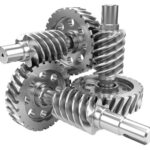Cam – A mechanical device used to transmit motion to a follower by direct contact. Where Cam – driver member
Follower – driven member.
The cam and the follower have line contact and constitute a higher pair.
In a cam – follower pair, the cam normally rotates at uniform speed by a shaft, while the follower may is predetermined, will translate or oscillate according to the shape of the cam. A familiar example is the camshaft of an automobile engine, where the cams drive the push rods (the followers) to open and close the valves in synchronization with the motion of the pistons.
Applications:
The cams are widely used for operating the inlet and exhaust valves of Internal combustion engines, automatic attachment of machineries, paper cutting machines, spinning and weaving textile machineries, feed mechanism of automatic lathes.
Example of cam action

Classification of Followers
(i) Based on surface in contact. (Fig.3.1)
(a) Knife edge follower
(b) Roller follower
(c) Flat faced follower
(d) Spherical follower

Fig. 3.1 Types of followers
(ii) Based on type of motion: (Fig. 3.2)
(a) Oscillating follower
(b) Translating follower

Fig.3.2
(iii) Based on line of motion:
(a) Radial follower: The lines of movement of in-line cam followers pass through the centers of the camshafts (Fig. 3.1a, b, c, and d).
(b) Off-set follower: For this type, the lines of movement are offset from the centers of the camshafts (Fig. 3.3a, b, c, and d).



